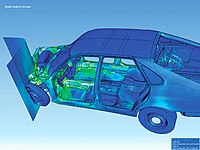
Photo from wikipedia
The JT-60SA toroidal field coils (TFC) are currently being manufactured in Europe, and their assembly is progressing at full speed in QST, Naka. As part of their final acceptance, the… Click to show full abstract
The JT-60SA toroidal field coils (TFC) are currently being manufactured in Europe, and their assembly is progressing at full speed in QST, Naka. As part of their final acceptance, the coils are tested at nominal current in a dedicated facility of CEA, Saclay. To help defining the cool down strategy for the testing of the TFCs, and also to anticipate their behavior during the cooling down of the JT-60SA tokamak, a fully three-dimensional finite element model of a TFC has been created, which includes finite elements with thermal, mechanical, and hydraulic formulations, to solve simultaneously the convective heat exchange between the helium coolant and the structures, the conductive heat exchange in the structures themselves, and the radiation heat exchange between the TFC and its surroundings. The model has been extensively used for predicting the behavior of the TFC during cool down and warm up, and the results have been benchmarked against the experimental evidence collected during the cold tests carried out in Europe. Several kind of analyses were carried out, from simple cool down simulations, to more sophisticated simulations of fast transient events, like the dynamic quench test which all TFCs have undergone. The model is built using the ANSYS commercial finite element code and is readily up-scalable to any size of similar magnets. This paper describes the rationale behind the definition of the model, and the results obtained in preparation of the first cold tests, and in view of the operation of the tokamak. The associated modeling challenges are reviewed and critically discussed.
Journal Title: IEEE Transactions on Applied Superconductivity
Year Published: 2018
Link to full text (if available)
Share on Social Media: Sign Up to like & get
recommendations!